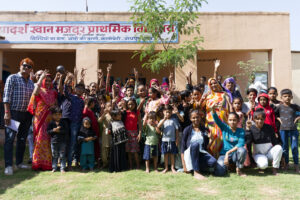The XertifiX PLUS-Certification

The PLUS label will be awarded once all the criteria of the standard certification (years 0 to 2) are met, plus the following criteria:
- Building and construction safety
- safe building structure
- Safety measures on machines (installation and usage) and valid inspection certificates and / or approvals for equipment (e.g. pneumatic drills) in accordance with the local law
- proper electrical installations (e.g. isolation of cables),
- elimination of tripping hazards,
- fire-preparedness (e.g. fire extinguishers),
- availability and accessibility of emergency exits,
- clear escape routes.
- Written company contracts also in the language of workers. Records of all workers (including temporary, seasonal and migrant workers) need to be kept. Identity cards for all workers.
- Setting up a workers’ grievance mechanism (e.g. through the workers’ representative and/or a complaint box, complaint phone number)
- Payment of living wage, if the minimum wage is below the living wage (ILO Convention 131)
- Paid annual leave and paid leave in case of sickness according to the local law
- No discrimination based on gender and pregnancy.
- Adequate work for pregnant women and special leave at pre- and post-delivery (according to local law, at least ILO 183)
- Provision of adequate facilities for babies and small children at workplace
- Equal wage for equal work (ILO 100)
- Company takes steps to protect women against sexual violence and harassment at the workplace.
- Compulsory annual improvements in working conditions, workers’ rights and environmental protection in the following two years.
Subsequent year 1:
- Protection of the surrounding area of the quarry and processing facilities against damage (e.g. caused by hazardous waste, dust, waste and sewage by natural stone production and processing, waste water slurry).
- The environmental impact must be evaluated by the producer. In case of detected potential environmental risks or negative impacts: the company documents these effects and develops a plan of concrete mitigation measures. Ensure monitoring that the mitigative measures are effective.
- Segregation, proper storage, and disposal of all kind of waste according to the local law (e.g. quarry waste, hazardous waste, waste water, waste water slurry, sludges, chemical containers, glass, plastics etc.). Where applicable, official documents for the disposal of the waste (e.g. disposal of sludges).
- Reduction of noise emission according to the local law (e.g. by setting limits to rock blasting times).
- Reduction of air pollution according to the local law (e.g. by filtering mechanisms)
- Recycling of material and/or re-use of materials (where applicable)
- Installation of a grievance mechanisms for affected communities (e.g. a system for reporting, assessing, and addressing complaints and claims by affected parties in the region where the economic activity is taking place.)
- Living conditions of the workers (if accommodation is provided)
- Separation of accommodation from production area.
- Availability of safe drinking water and sanitation facilities
- Reasonable levels of decency, hygiene, and comfort (ILO recommendation 115–II) according to the local customs
- No excessive and inadequate charging for the provided accommodation.
- Verfügbarkeit von sauberem Trinkwasser und sanitären Einrichtungen.
- Angemessenes Maß an Anstand, Hygiene und Komfort (Empfehlung 115-II der IAO) nach den lokalen Gepflogenheiten.
- Keine übermäßige und unangemessene Erhebung von Gebühren für die zur Verfügung gestellten Unterkünfte.
Subsequent year 2:
- Minimize the negative effects on the ecosystem according to the local law (e.g. by offsetting the residual net loss of biodiversity). Ensure adequate financial resources for this purpose.
- Safeguard of legally protected and internationally recognized areas
- Energy Management: Develop and implement energy management measures (e.g. by the replacement of old power consuming machines by newer power saving ones or other power saving equipment, and usage of renewable energy sources (RES)
- Laws: Availability of all relevant official environmental documents and permits (e.g. water use and land use titles).
- Legality: Compliance with local and national laws and regulations
- Implementation of a written down anti-corruption and anti-bribery policy. (template available)
- No visible evidence of or feedback about corruption and bribery.
- All policies should be communicated to all employees and must be publicly accessible.
Compliance with the criteria must be proven by at least one audit per year (see above). If the criteria are not met in the first audit, this must be confirmed by a further audit (etc.). The ongoing fulfillment of the criteria once achieved is also verified. This means that the XertifiX certifications are only valid for one year.

